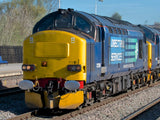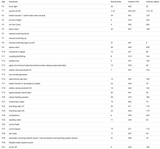With 309 units built, the Class 37, originally built as the English Electric Type 3, was a familiar sight on English main and branch lines from 1967. The power for the six electric traction motors was initially generated by a 1305 kW English Electric twelve-cylinder 12CSVT diesel engine. Originally, most locomotives for heating passenger trains were equipped with a steam boiler; some locomotives that were initially delivered without a boiler for cost reasons were retrofitted with the component in the 1970s. The Class 37/4 substructure series was created in 1980 because the BR exchanged the steam boiler for electric train heating. In the 1980s, worn diesel engines were replaced with new Mirrless Blackstone or Ruston engines. Maximum speed was 130 km/h. Some of the reliable six-axle vehicles are still in service today.
Different starting processes can be selected with F1: 1x press button = warm start / press button 2x = false start / press button 3x = cold start
F2 slows down the locomotive slowly.
F5 enables the heavy load mode: The diesel notch is always one up compared with normal operation. If you want to jump two notches, simply set CV 104 to 150 (instead of 130).
F8 turns on the manual ntoching. Once F8 is on, you can use F7 to notch up and F6 to notch down. F8, F6, and F7 must be turned off to return to normal mode. If F8 is off and you press F7, the prime mover will run to full speed.
F14, F18 and CV 170 value 0 or 1, can switch between a "normal announcement" or an announcement "with gong".
F9 can increase the speed of the spirax valve by double-clicking it. The speed levels are slow, medium and fast.
17 will bring the locomotive to full stop.
F21 and CV 168 = value 0 or 1, can switch between a "normal" or a "squeaking" wiper.
F28 and CV 164 = Value 0, 1, 2 or 3, can switch between different rail joints (three coupler can be activated with CV 165 = value 1).
F29 and CV 169 = value 0 or 1, can switch between the "Automatic Warning System (AWS)" or the "Train Protection and Warning System (TPWS)".




